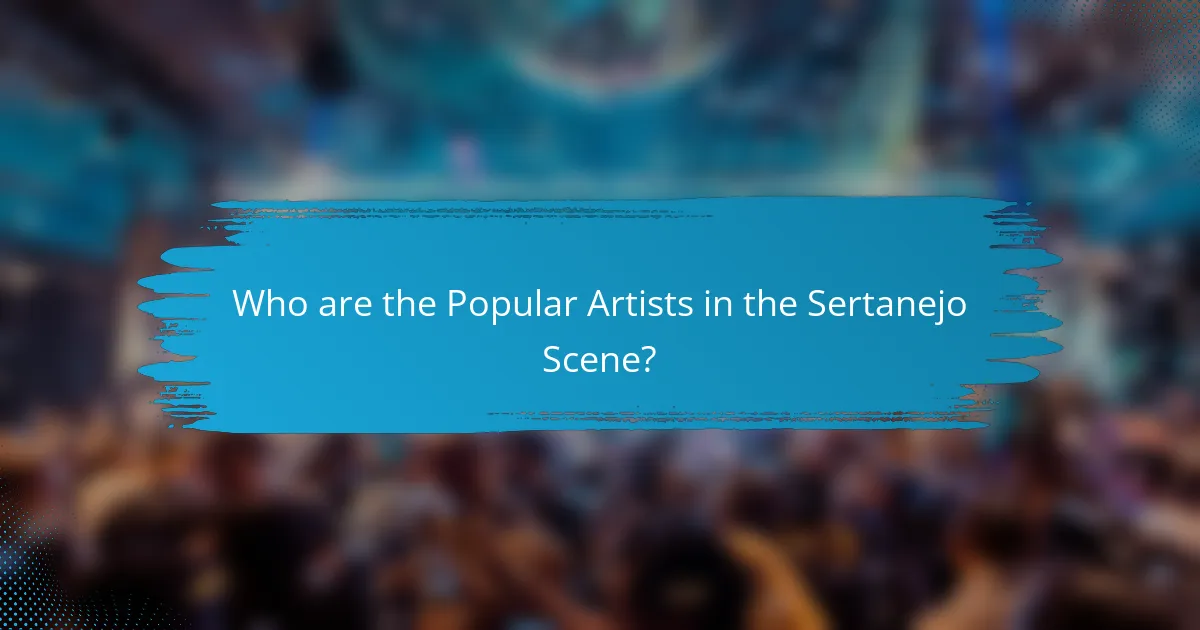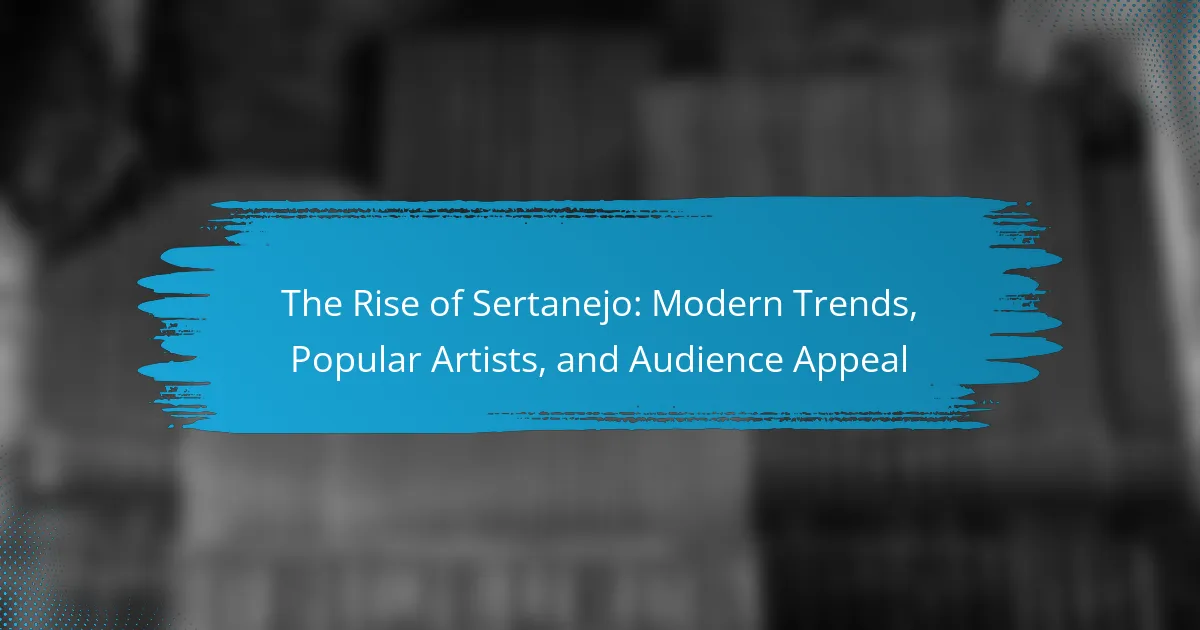Sertanejo is a prominent genre of Brazilian music that originated in the rural countryside in the early 20th century, drawing from folk traditions and European influences. It has evolved from its acoustic roots to incorporate modern pop and electronic elements, gaining substantial popularity in the 1980s and 1990s through artists like Chitãozinho e Xororó. Today, Sertanejo is a leading force in Brazil’s music scene, characterized by its diverse audience appeal, relatable themes, and significant presence on streaming platforms and at major festivals. The genre continues to adapt, with contemporary artists such as Zezé Di Camargo & Luciano and Jorge & Mateus redefining its sound and expanding its reach through collaborations and modern lyrical themes.

What is Sertanejo and its Historical Context?
Sertanejo is a popular genre of Brazilian music originating from the rural countryside. It emerged in the early 20th century, influenced by folk traditions and European musical styles. Sertanejo reflects the life and culture of Brazil’s rural communities. Over time, it evolved from acoustic roots to incorporate modern elements such as pop and electronic music. The genre gained significant popularity in the 1980s and 1990s with artists like Chitãozinho e Xororó. Today, Sertanejo is a dominant force in Brazil’s music scene, with major festivals and a large fan base. Its historical context is tied to Brazil’s socio-economic changes, including urbanization and cultural shifts.
How did Sertanejo music originate and evolve over time?
Sertanejo music originated in the rural regions of Brazil in the early 20th century. It began as a form of folk music, influenced by traditional Brazilian country styles. Initially, Sertanejo was performed by duos using acoustic guitars and harmonicas. Over time, it gained popularity in urban areas, especially during the 1980s. The genre evolved to include modern instruments and production techniques. Artists began to incorporate elements from pop and rock music. Today, Sertanejo is one of Brazil’s most popular music genres. It features a diverse range of themes, including love and rural life. The evolution of Sertanejo reflects changes in Brazilian culture and society.
What are the key influences that shaped Sertanejo’s development?
Sertanejo’s development was shaped by various influences including traditional rural music, American country music, and regional Brazilian folk styles. Traditional rural music provided the foundational melodies and themes, reflecting the lives of rural communities. American country music introduced new instrumentation and stylistic elements, enhancing the genre’s appeal. Regional Brazilian folk styles contributed unique rhythms and cultural narratives, enriching Sertanejo’s diversity. Additionally, the evolution of media, such as radio and television, facilitated broader exposure and popularity. The rise of modern technology, particularly digital platforms, has further transformed how Sertanejo is produced and consumed. These influences collectively contributed to Sertanejo’s evolution into a prominent music genre in Brazil.
How did cultural and social factors contribute to the rise of Sertanejo?
Cultural and social factors significantly contributed to the rise of Sertanejo music. This genre emerged from rural Brazil, reflecting the lifestyle and values of country living. The migration of people to urban areas in the late 20th century brought these rural influences to cities. Sertanejo’s themes of love, heartbreak, and everyday life resonated with a broad audience.
The genre adapted to incorporate elements from pop and rock, appealing to younger listeners. Social gatherings and festivals played a crucial role in popularizing Sertanejo, fostering a sense of community. The rise of media platforms, such as radio and television, further amplified its reach.
Notably, the 1990s saw the emergence of popular Sertanejo duos, which helped solidify its place in mainstream music. By the 2000s, Sertanejo became a dominant genre in Brazil, reflecting its deep cultural roots and social relevance.
What are the defining characteristics of Sertanejo music?
Sertanejo music is characterized by its blend of traditional Brazilian folk sounds and contemporary influences. It often features acoustic instruments such as violas and guitars. The lyrics typically revolve around themes of love, rural life, and heartbreak. Sertanejo has evolved into a popular genre, especially in Brazil’s central and southern regions. The style has diversified into subgenres, including Sertanejo Universitário, which incorporates pop elements. Notable artists like Zezé Di Camargo & Luciano have significantly contributed to its popularity. The genre’s rise can be attributed to its appeal among younger audiences and its integration into mainstream media.
What musical elements distinguish Sertanejo from other genres?
Sertanejo is distinguished by its unique blend of traditional Brazilian folk music and contemporary influences. It features acoustic instruments like the viola caipira, which is central to its sound. The genre often incorporates elements of pop and rock, creating a modern appeal. Lyrically, Sertanejo focuses on themes of love, rural life, and personal experiences. This contrasts with other genres that may prioritize different themes or musical structures. The use of harmonies and duets is also prominent, enhancing the emotional depth of the songs. Sertanejo has evolved to include electronic elements, which further sets it apart from traditional folk genres. Its popularity has surged in recent years, with artists like Zezé Di Camargo & Luciano achieving significant commercial success.
How do lyrics and themes reflect the culture of Sertanejo?
Sertanejo lyrics and themes reflect Brazilian rural life and social issues. They often portray love, heartbreak, and family values. Many songs celebrate the simplicity and beauty of countryside living. Common themes include nostalgia for traditional lifestyles and the struggles of rural communities. The genre also addresses contemporary topics like urban migration and economic challenges. This connection to cultural identity resonates with audiences across Brazil. Sertanejo artists frequently draw from personal experiences, enhancing authenticity. The music serves as a voice for the emotions and realities faced by many in the Sertanejo community.

What are the Modern Trends in Sertanejo?
Modern trends in Sertanejo include a fusion of traditional sounds with contemporary styles. Artists are increasingly incorporating pop and electronic elements into their music. This blend appeals to younger audiences and expands the genre’s reach. Collaborations with international artists are also on the rise. Notable examples include partnerships with pop and hip-hop musicians. Streaming platforms have significantly influenced the distribution and popularity of Sertanejo music. Social media plays a crucial role in promoting new artists and songs. Additionally, themes in lyrics are evolving to reflect modern lifestyles and social issues. These trends demonstrate Sertanejo’s adaptability and ongoing relevance in today’s music scene.
How has technology influenced the production and distribution of Sertanejo?
Technology has significantly influenced the production and distribution of Sertanejo music. Digital recording software has streamlined the music production process. This allows artists to produce high-quality tracks from home studios. Social media platforms have transformed how Sertanejo artists connect with their audience. Artists can now share their music directly with fans on platforms like Instagram and YouTube. Streaming services have also changed distribution methods. Sertanejo music is now accessible globally through platforms like Spotify and Apple Music. This broadens the audience reach and increases potential revenue streams for artists. Additionally, online marketing strategies have become essential for promoting new releases. These technological advancements have reshaped the landscape of Sertanejo music.
What role do social media and streaming platforms play in popularizing Sertanejo?
Social media and streaming platforms significantly contribute to the popularization of Sertanejo music. They provide artists with direct access to audiences, bypassing traditional media gatekeepers. Social media enables fans to share music and engage with artists, creating viral trends. Streaming platforms offer extensive libraries, allowing listeners to discover and enjoy Sertanejo tracks easily. This accessibility leads to increased exposure for both established and emerging Sertanejo artists. Data shows that streaming services like Spotify have playlists dedicated to Sertanejo, enhancing its reach. Additionally, social media platforms like Instagram and TikTok allow for creative content that showcases Sertanejo’s cultural relevance. These dynamics collectively enhance the genre’s visibility and popularity among diverse demographics.
How has the sound of Sertanejo changed in recent years?
The sound of Sertanejo has evolved significantly in recent years. Traditional elements have been blended with pop and electronic influences. This fusion has created a more mainstream appeal. Artists are now incorporating modern production techniques. The lyrical themes have also shifted towards contemporary issues and emotions. Collaborations with pop artists have increased, broadening the genre’s reach. Streaming platforms have played a crucial role in this transformation. Data shows a rise in Sertanejo’s popularity in urban areas, reflecting its growing audience.
What collaborations and cross-genre influences are emerging in Sertanejo?
Collaborations and cross-genre influences in Sertanejo are increasingly prominent. Artists are blending Sertanejo with pop, funk, and electronic music. This fusion creates a diverse sound that appeals to wider audiences. Notable collaborations include Sertanejo artists working with pop singers like Anitta and Ivete Sangalo. These partnerships enhance the genre’s mainstream visibility. Additionally, Sertanejo has incorporated elements from hip-hop, evident in tracks featuring rappers. This cross-pollination enriches the musical landscape and attracts younger listeners. The trend reflects a dynamic evolution within Sertanejo, showcasing its adaptability and relevance in contemporary music.
Which artists are leading the way in innovative Sertanejo collaborations?
Artists leading the way in innovative Sertanejo collaborations include Jorge & Mateus, Zezé Di Camargo & Luciano, and Marília Mendonça. Jorge & Mateus frequently collaborate with pop and electronic artists, blending genres. Zezé Di Camargo & Luciano have worked with various artists to modernize their sound. Marília Mendonça’s collaborations often feature rising stars, pushing the boundaries of traditional Sertanejo. These artists are redefining the genre and expanding its audience. Their innovative approaches reflect the evolving landscape of Sertanejo music.
How does blending genres enhance the appeal of Sertanejo music?
Blending genres enhances the appeal of Sertanejo music by creating a diverse sound that attracts a wider audience. This fusion incorporates elements from pop, rock, and traditional Brazilian music. As a result, Sertanejo becomes more relatable to different demographic groups. The incorporation of contemporary rhythms makes it more accessible to younger listeners. Additionally, collaborations with artists from various genres broaden its reach. This genre-blending often leads to innovative musical styles that keep the genre fresh. For instance, the integration of electronic music has gained significant popularity in recent years. Ultimately, these genre combinations help Sertanejo maintain relevance in a competitive music market.

Who are the Popular Artists in the Sertanejo Scene?
Popular artists in the Sertanejo scene include Zezé Di Camargo & Luciano, Chitãozinho & Xororó, and Jorge & Mateus. These artists have significantly influenced the genre’s popularity. For instance, Zezé Di Camargo & Luciano have sold over 30 million albums. Chitãozinho & Xororó are considered pioneers, having started their career in the 1970s. Jorge & Mateus are known for their contemporary style and have numerous chart-topping hits. Other notable names include Gusttavo Lima and Marília Mendonça, who have brought fresh energy to Sertanejo music. Their contributions have shaped the modern landscape of the genre.
Which artists are currently dominating the Sertanejo charts?
Currently, artists such as Marília Mendonça, Jorge & Mateus, and Zezé Di Camargo & Luciano are dominating the Sertanejo charts. Marília Mendonça consistently ranks high due to her emotional lyrics and powerful vocals. Jorge & Mateus are known for their catchy melodies and have a strong fan base. Zezé Di Camargo & Luciano bring a classic touch to the genre, appealing to both older and younger audiences. Their recent hits have contributed significantly to their chart success.
What unique attributes do these artists bring to the genre?
These artists bring a blend of traditional and contemporary influences to the Sertanejo genre. Their unique sound often incorporates elements from pop, rock, and electronic music. This fusion attracts a wider audience beyond traditional Sertanejo fans. Many of these artists also emphasize storytelling in their lyrics, reflecting personal experiences and social issues. Their collaborations with international artists further broaden the genre’s appeal. Additionally, they utilize modern production techniques to enhance the overall listening experience. The visual presentation of their music, including music videos and live performances, adds another layer of engagement. These attributes collectively contribute to the evolution and popularity of Sertanejo music today.
How have these artists contributed to the evolution of Sertanejo music?
These artists have significantly shaped Sertanejo music through innovation and collaboration. They have introduced contemporary themes and modern production techniques. For example, artists like Jorge & Mateus and Zezé Di Camargo & Luciano have blended Sertanejo with pop and electronic influences. This fusion has attracted younger audiences and expanded the genre’s appeal. Additionally, they have popularized the use of social media and streaming platforms for music distribution. This approach has increased accessibility and engagement with fans. Their contributions have led to Sertanejo becoming a dominant genre in Brazil’s music scene. The evolution reflects a shift from traditional roots to a more diverse and modern sound.
What are the key factors behind the success of Sertanejo artists?
The key factors behind the success of Sertanejo artists include strong cultural roots, emotional connection, and strategic marketing. Sertanejo music resonates deeply with Brazilian culture, reflecting themes of love, rural life, and everyday struggles. This emotional connection fosters a loyal fan base. Additionally, the genre has evolved to incorporate modern influences, appealing to younger audiences. Strategic marketing through social media and collaborations with popular artists enhances visibility. Live performances and festivals play a crucial role in engaging fans and building a brand. The growth of streaming platforms has also expanded their reach, making Sertanejo accessible to a wider audience.
How do marketing strategies affect the visibility of Sertanejo artists?
Marketing strategies significantly enhance the visibility of Sertanejo artists. Effective marketing increases audience reach and engagement. Social media campaigns are particularly influential. They allow artists to connect directly with fans. Collaborations with influencers amplify their presence. Targeted advertising on digital platforms boosts exposure. Live performances and events also play a crucial role. They create memorable experiences that attract larger audiences. Data shows that artists with strong marketing efforts gain more followers. This leads to increased streaming and sales. Thus, strategic marketing is essential for Sertanejo artists’ success.
What role does live performance play in an artist’s success in Sertanejo?
Live performance is crucial for an artist’s success in Sertanejo. It allows artists to connect directly with their audience. Engaging performances can enhance an artist’s popularity and fan base. Sertanejo concerts often attract large crowds, showcasing the genre’s vibrant culture. Successful artists frequently tour to maintain visibility and relevance. Live shows also provide opportunities for merchandise sales and sponsorships. Furthermore, social media amplifies the reach of live performances, creating buzz and attracting new fans. Overall, live performance solidifies an artist’s presence in the competitive Sertanejo landscape.

What is the Audience Appeal of Sertanejo?
Sertanejo appeals to a diverse audience due to its relatable themes and catchy melodies. The genre often explores love, heartbreak, and rural life, resonating with many listeners. Its blend of traditional and modern influences attracts both older and younger fans. Popular artists like Zezé Di Camargo and Chitãozinho & Xororó have massive followings, contributing to its popularity. The genre’s presence at major festivals and on streaming platforms enhances its accessibility. In 2020, Sertanejo accounted for 30% of Brazil’s music market, showcasing its significant audience reach. This widespread appeal is also fueled by its incorporation of contemporary musical elements.
Who comprises the primary audience for Sertanejo music?
The primary audience for Sertanejo music consists mainly of young adults and rural populations in Brazil. This demographic is often characterized by their cultural ties to the countryside and traditional Brazilian values. Sertanejo music resonates with listeners who appreciate themes of love, heartbreak, and rural life. The genre has gained popularity among urban youth as well, especially in social gatherings and festivals. According to a 2020 survey, over 30% of Brazilian music listeners prefer Sertanejo, indicating its widespread appeal. This popularity is reflected in the success of Sertanejo artists in mainstream media and music charts.
What demographic trends can be observed among Sertanejo listeners?
Sertanejo listeners predominantly belong to younger demographics, particularly those aged 18 to 35. This age group shows a strong affinity for the genre, especially in urban areas. Additionally, there is a notable gender balance among listeners, with both male and female audiences equally engaging with Sertanejo music.
Geographically, Sertanejo is most popular in Brazil’s central and southern regions, reflecting cultural roots in these areas. The genre appeals to diverse socioeconomic backgrounds, attracting listeners from both urban and rural settings.
Recent studies indicate that Sertanejo’s fan base is increasingly influenced by social media platforms, which facilitate music discovery among younger audiences. Streaming services have also contributed to the genre’s reach, allowing listeners to access a wide array of Sertanejo artists.
Overall, Sertanejo listeners are characterized by their youth, gender balance, regional concentration, and engagement with digital media.
How does Sertanejo resonate with different cultural backgrounds?
Sertanejo resonates with different cultural backgrounds through its blend of traditional and contemporary musical elements. The genre incorporates influences from Brazilian folk music, rock, and pop, making it accessible to diverse audiences. This fusion allows Sertanejo to appeal to both rural and urban listeners. Additionally, its themes often reflect universal emotions like love and heartbreak, which transcend cultural barriers. The genre has seen collaborations with international artists, further broadening its reach. Events like Sertanejo music festivals attract attendees from various backgrounds, showcasing its widespread popularity. This cultural adaptability contributes to Sertanejo’s growing prominence in Brazil and beyond.
What emotional and social connections do audiences have with Sertanejo?
Audiences have deep emotional and social connections with Sertanejo music. This genre often evokes feelings of nostalgia and belonging. Many fans associate Sertanejo with family gatherings and celebrations. The lyrics frequently explore themes of love, heartbreak, and rural life. These relatable topics resonate with listeners’ personal experiences.
Sertanejo also fosters a sense of community among fans. Concerts and festivals create shared experiences that strengthen social bonds. The genre’s popularity reflects cultural identity, particularly in Brazil’s interior regions. Data shows that Sertanejo concerts attract large audiences, highlighting its social significance.
Overall, Sertanejo serves as a vehicle for emotional expression and social connection.
How does Sertanejo music foster community and cultural identity?
Sertanejo music fosters community and cultural identity by serving as a reflection of Brazilian rural life. It connects individuals through shared experiences and traditions. The lyrics often depict themes of love, hardship, and celebration, resonating with listeners’ personal stories. Sertanejo gatherings, such as festivals, promote social interaction and cultural exchange. These events strengthen bonds among community members. The genre also highlights regional pride, showcasing local dialects and customs. This cultural representation reinforces a sense of belonging among fans. Studies indicate that music genres like Sertanejo play a crucial role in cultural identity formation.
What are the common themes that audiences relate to in Sertanejo songs?
Common themes in Sertanejo songs include love, heartbreak, and rural life. These themes resonate deeply with audiences in Brazil. Love is often portrayed as passionate and sometimes tumultuous. Heartbreak songs express feelings of loss and longing. Rural life is celebrated through references to nature and traditional values. Family and friendship are also significant themes. Additionally, many songs reflect on social issues and personal struggles. These relatable themes contribute to the genre’s widespread popularity.
What are some tips for engaging with Sertanejo music and culture?
To engage with Sertanejo music and culture, start by listening to popular artists like Zezé Di Camargo & Luciano and Jorge & Mateus. Attend live Sertanejo concerts to experience the music’s vibrant atmosphere. Explore the cultural significance of Sertanejo by understanding its roots in Brazilian rural life. Participate in local festivals that celebrate Sertanejo music, such as Festa do Peão de Barretos. Learn the lyrics and sing along to connect more deeply with the songs. Try traditional dishes often enjoyed during Sertanejo events, enhancing your cultural experience. Follow Sertanejo music channels on social media for updates on new releases and events. Finally, engage with communities of Sertanejo fans online to share experiences and recommendations.
How can newcomers best explore the Sertanejo genre?
Newcomers can best explore the Sertanejo genre by listening to popular artists and playlists. Key artists include Zezé Di Camargo & Luciano, Jorge & Mateus, and Marília Mendonça. Streaming platforms often feature curated Sertanejo playlists. Attending live concerts and festivals offers an immersive experience. Engaging with online communities can enhance understanding of the genre’s cultural context. Exploring music videos provides visual storytelling that complements the music. Reading articles and watching documentaries about Sertanejo’s history enriches knowledge. These methods collectively provide a comprehensive introduction to Sertanejo music.
What events and platforms are recommended for experiencing Sertanejo live?
Major events for experiencing Sertanejo live include the VillaMix Festival and the Sertanejo Music Festival. These festivals showcase top artists and attract large audiences. Platforms like YouTube and Instagram Live also offer live performances and interactions with fans. In Brazil, local bars and clubs frequently host Sertanejo nights featuring emerging artists. These venues provide an intimate setting for fans to enjoy the music. The popularity of Sertanejo has led to increased live performances across the country.
Sertanejo is a prominent genre of Brazilian music that originated in rural areas in the early 20th century, evolving from traditional folk roots to incorporate modern pop and electronic elements. The article explores Sertanejo’s historical context, key influences, defining characteristics, and the cultural and social factors that contributed to its rise in popularity. It highlights modern trends, popular artists, and the genre’s appeal to diverse audiences, emphasizing the emotional connections and community aspects that Sertanejo fosters. Additionally, it examines how technology and marketing strategies have shaped the production and visibility of Sertanejo music in today’s music scene.
